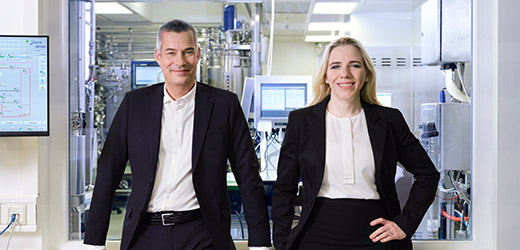Workplace Safety
Workplace and plant safety are vitally important for WACKER. That is why WACKER defines safety targets together with its executives (upper and middle management) in Germany during its annual target-setting process. Systematic workplace safety includes regular evaluation of hazards and work-area monitoring. We align our processes and standards relating to occupational health and safety with the international ISO 45001 standard. The site in Jincheon, South Korea, is certified to the new ISO 45001:2018 standard.
All our employees are given compulsory safety training tailored to their particular work areas. WACKER Germany, for example, offers over 40 online courses on occupational safety issues. Topics range from general safety guidelines for office and laboratory workers to instruction on safe behavior in potentially explosive atmospheres and the classification of hazardous materials.
The trend in workplace accidents is one of the most important non-financial performance indicators. We have set a goal of keeping the number of workplace accidents to below 2.0 per million hours worked groupwide. The Group’s accident rate improved slightly in the reporting year, with 3.5 workplace accidents per million hours worked, compared with 3.6 in the previous year. The relative improvement in Europe’s regional accident rate was almost canceled out by an opposing trend in Asia and the Americas. However, our Asian sites continued to report substantially fewer workplace accidents than our sites in Europe and the USA. To lower the accident rate in Europe, we started a safety initiative at our Burghausen and Nünchritz sites involving action days, inspection tours, checklists and a competition of ideas; other German sites joined the initiative in the first quarter of 2023.
In the reporting year, a fatal workplace accident occurred at our Amtala site in India due to an insufficiently secured, temporary hole in the floor of a construction site. As an immediate response, it was decided, among other things, that construction-site areas would be rigorously cordoned off, more detailed assessments performed of the dangers involved in similar work and employees given specific refresher training courses. Alongside these measures, the site launched a safety initiative that focuses on the reporting of near-misses and safety-critical situations. In addition, external and internal safety audits were conducted and action points to raise safety standards were prepared and implemented. Violations of safety regulations will be punished severely.
|
|
|
|
|
|
|
|||
|
|
2022 |
|
2021 |
|
2020 |
|||
|---|---|---|---|---|---|---|---|---|---|
|
|
|
|
|
|
|
|||
Accident rate: Group – accidents1 per million hours worked |
|
3.5 |
|
3.6 |
|
3.0 |
|||
Accident rate: Europe |
|
4.3 |
|
4.7 |
|
3.3 |
|||
Accident rate: The Americas |
|
2.3 |
|
1.3 |
|
3.2 |
|||
Accident rate: Asia |
|
1.4 |
|
0.6 |
|
1.3 |
|||
Chemical accidents with missed workdays1 |
|
10 |
|
4 |
|
3 |
|||
Fatal accidents |
|
1 |
|
– |
|
– |
|||
|
|||||||||
Very few accidents at WACKER involve chemicals. The most common causes are tripping, slipping, falling and lack of care when performing manual activities. We are never satisfied with our accident rate, and we regularly update our workplace safety initiatives.
We raise awareness of employees to help them identify and avoid unsafe behavior through our WACKER Safety Plus (WSP) program, in which we build on elements of successful safety strategies at sites with particularly low accident rates – such as safety patrols, emergency drills and holding discussions with the workforce.

